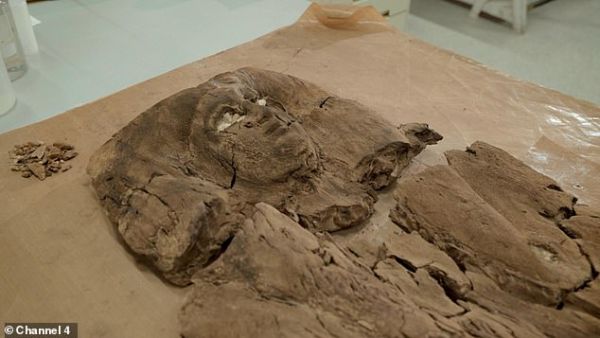Archaeologists have revealed the face of an Egyptian princess who lived almost 4,000 years ago by painstakingly piecing together the wooden shards of her sarcophagus.
The fragments expose the likeness of a royal, possibly Princess Hatshepset, daughter of Pharoah Ameny Qemau, who lived towards the end of Egypt's Middle Kingdom.
Her image will be seen for the first time on Channel 4's Egypt's Lost Pyramid programme, which follows the two-year excavation and study of the royal's final resting place.
The pyramid from the 13th dynasty was found in Dahshur's royal necropolis, 20 miles south of Cairo, in 2017, and was found to have been ransacked by thieves after it was opened.
The coffin had been split open so that the priceless jewels could be ripped from her corpse, before the royal's bones were scattered across the floor.
Archaeologists at the American University of Cairo cleaned the pieces before placing them in formation.
It reveals the face of a woman who is wearing a hathor wig, a powerful symbol of fertility, that was very popular during the Middle Kingdom.
'Coffins normally had features that were similar to the owner but idealised because that's what they would look like for eternity', Egyptologist Dr Yasmin El Shazly said.
{"preview_thumbnail":"https://cdn.flowplayer.com/6684a05f-6468-4ecd-87d5-a748773282a3/i/v-i-a…","video_id":"adca9bde-51c4-49ad-9385-7a81fcb65c71","player_id":"8ca46225-42a2-4245-9c20-7850ae937431","provider":"flowplayer","video":"Restriction Returns to Kashmir Ahead of Late-night Protest"}
'Why would I want to look ugly for eternity?'
When the granite block was first moved in 2017, it revealed a disturbed burial ground which contained shattered bits of wood.
The box containing the canopic jars, which held her liver, lungs, stomach and intestines, also remained. On one side it says 'daughter of the king' written in hieroglyphs.
The assertion that this is Princess Hatshepset's tomb comes from an inscription on the box containing the canopic jars, reports Live Science.
At the end of the programme Egyptologist Dr Chris Morgan makes the startling claim that the tomb may have been raided before the door was sealed, suggesting that priests may have been involved.
She died towards the end of the Middle Kingdom, which dates from 2030 to 1782 BC.
As the period drew to a close, Egypt lost control of Lower Nubia and experienced bouts of famine and political unrest.
While the 13th dynasty, during which Ameny Qemau ruled briefly, was reasonably prosperous, the Second Intermediate Period may have been impoverished, according to archaeologists.
Her tomb is less than a mile from her father's, according to the programme, which has been nicknamed the 'black pyramid'.
The structure itself now looks like a pile of rubble, as the precious limestone was removed from the outside, leaving the mud-brick interior exposed to the elements.
Beneath there are winding corridors to confuse raiders along with three separate hidden chambers for the Pharoah and his two queens.
Despite their efforts, these were also raided by tomb robbers. Only the box that held the canopic jars belonging to one of the Queen's remained, which would have held her stomach, lungs, liver and intestines.
This article has been adapted from its original source.








